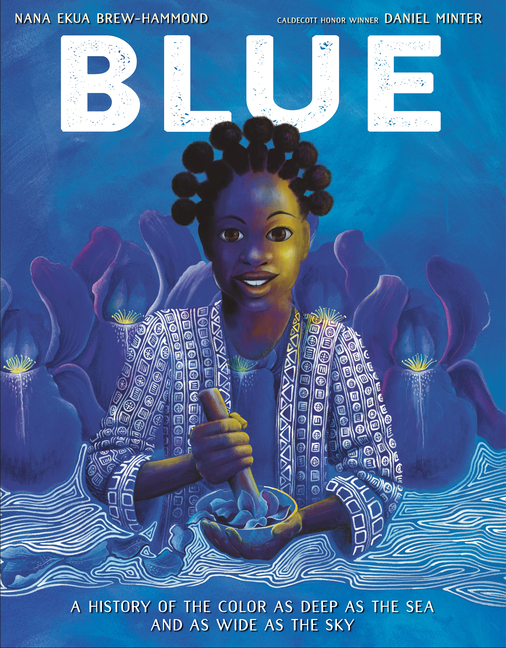Book Descriptions
for Blue by Nana Ekua Brew-Hammond and Daniel Minter
From Cooperative Children's Book Center (CCBC)
Do colors have histories? Brew-Hammond reveals that blue most certainly does. Although people have always been able to see the color blue in the sky, lakes, and oceans, recreating blue is another matter. The earliest known use of blue was in 4500 BC when miners in Afghanistan extracted a blue rock, lapis lazuli, from the ground. Because it was both difficult to extract and to turn into paint, blue was prized in ancient Egypt, where it became associated with wealth and royalty. Elsewhere in the world—the Mediterranean, Japan, Central America, and Mexico—people learned to extract blue from a particular type of snail, another painstaking process. Once a group of plants called Indigofera, found in parts of Asia, Africa, the Caribbean, and the Americas, was discovered, blue became cheaper to produce but was still precious; people throughout the world, including the United States, were exploited and enslaved to grow and harvest it in this “evil side of the trade for blue.” After working in his lab for 40 years, scientist Adolf von Baeyer won the Nobel Prize in 1905 for creating a chemical blue, an advance that made blue more accessible. This fascinating, meticulously researched history also conjectures about social and emotional connections to blue—feeling blue, blues music, blue jeans, and blue ribbons. End matter includes an author’s note, additional facts, and sources. Minter’s layered acrylic and watercolor art highlights the richness of the color blue and shows mostly historical and contemporary Black and Indigenous peoples throughout. (Ages 7-10)
CCBC Book of the Week. © Cooperative Children's Book Center, Univ. of Wisconsin - Madison, 2022. Used with permission.
From the Publisher
Discover a world of creativity and tradition in this fascinating picture book that explores the history and cultural significance of the color blue. From a critically acclaimed author and an award-winning illustrator comes a vivid, gorgeous book for readers of all ages.
NAMED ONE OF THE BEST BOOKS OF THE YEAR BY NPR • New York Public Library • Chicago Public Library • Kirkus Reviews
For centuries, blue powders and dyes were some of the most sought-after materials in the world. Ancient Afghan painters ground mass quantities of sapphire rocks to use for their paints, while snails were harvested in Eurasia for the tiny amounts of blue that their bodies would release.
And then there was indigo, which was so valuable that American plantations grew it as a cash crop on the backs of African slaves. It wasn't until 1905, when Adolf von Baeyer created a chemical blue dye, that blue could be used for anything and everything--most notably that uniform of workers everywhere, blue jeans.
Nana Ekua Brew-Hammond's riveting text combined with stunning illustrations from Caldecott Honor Artist Daniel Minter, this vibrant and fascinating picture book follows one color's journey through time and across the world, as it becomes the blue we know today.
NAMED ONE OF THE BEST BOOKS OF THE YEAR BY NPR • New York Public Library • Chicago Public Library • Kirkus Reviews
For centuries, blue powders and dyes were some of the most sought-after materials in the world. Ancient Afghan painters ground mass quantities of sapphire rocks to use for their paints, while snails were harvested in Eurasia for the tiny amounts of blue that their bodies would release.
And then there was indigo, which was so valuable that American plantations grew it as a cash crop on the backs of African slaves. It wasn't until 1905, when Adolf von Baeyer created a chemical blue dye, that blue could be used for anything and everything--most notably that uniform of workers everywhere, blue jeans.
Nana Ekua Brew-Hammond's riveting text combined with stunning illustrations from Caldecott Honor Artist Daniel Minter, this vibrant and fascinating picture book follows one color's journey through time and across the world, as it becomes the blue we know today.
Publisher description retrieved from Google Books.


